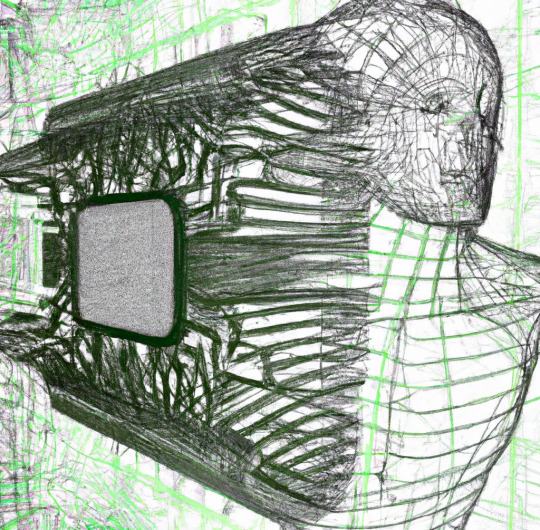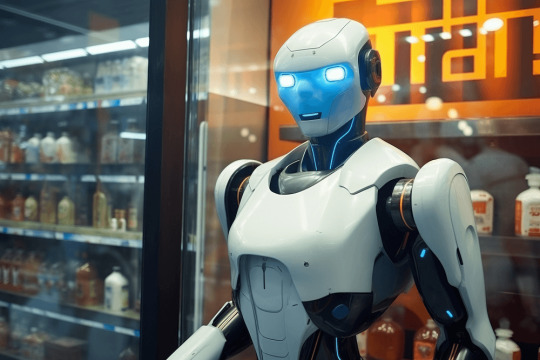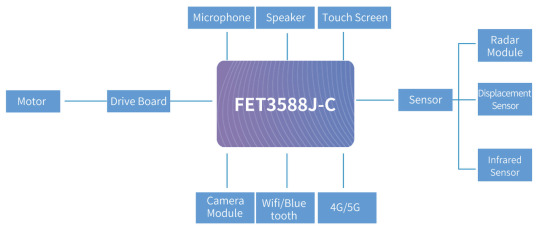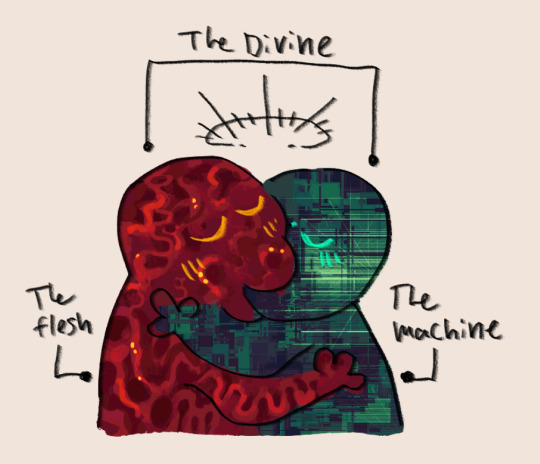#Machine Vision
Explore tagged Tumblr posts
Text

The Perception Machine: Our Photographic Future between the Eye and AI : Joanna Zylinska : Free Download, Borrow, and Streaming : Internet Archive
3 notes
·
View notes
Text

Week in Review
October 23rd-29th
Welcome to Fragile Practice, where I attempt to make something of value out of stuff I have to read.
My future plan is to do longer-form original pieces on interesting topics or trends. For now, I'm going to make the weekly reviews habitual and see if I have any time left.

Technology
OpenAI forms team to study ‘catastrophic’ AI risks, including nuclear threats - Tech Crunch; Kyle Wiggers
OpenAI launched a new research team called AI Safety and Security to investigate the potential harms of artificial intelligence focused on AI alignment, AI robustness, AI governance, and AI ethics.
Note: Same energy as “cigarette company funds medical research into smoking risks”.
Artists Allege Meta’s AI Data Deletion Request Process Is a ‘Fake PR Stunt’ - Wired; Kate Knibbs
Artists who participated in Meta’s Artificial Intelligence Artist Residency Program accused the company of failing to honor their data deletion requests and claim that Meta used their personal data to train its AI models without their consent.
Note: Someday we will stop being surprised that corporate activities without obvious profit motive are all fake PR stunts.
GM and Honda ditch plan to build cheaper electric vehicles - The Verge; Andrew J. Hawkins
General Motors and Honda cancel their joint venture to develop and produce cheaper electric vehicles for the US market, citing the chip shortage, rising costs of battery materials, and the changing market conditions.
Note: What are the odds this isn’t related to the 7 billion dollars the US government announced to create hydrogen hubs.
'AI divide' across the US leaves economists concerned - The Register; Thomas Claburn
A new study by economists from Harvard University and MIT reveals a significant gap in AI adoption and innovation across different regions in the US.
The study finds that AI usage is highest in California's Silicon Valley and the San Francisco Bay Area, but was also noted in Nashville, San Antonio, Las Vegas, New Orleans, San Diego, and Tampa, as well as Riverside, Louisville, Columbus, Austin, and Atlanta.
Nvidia to Challenge Intel With Arm-Based Processors for PCs - Bloomberg; Ian King
Nvidia is using Arm technology to develop CPUs that would challenge Intel processors in PCs, and which could go on sale as soon as 2025.
Note: I am far from an NVIDIA fan, but I’m stoked for any amount of new competition in the CPU space.
New tool lets artists fight AI image bots by hiding corrupt data in plain sight - Engadget; Sarah Fielding
A team at the University of Chicago created Nightshade, a tool that lets artists fight AI image bots by adding undetectable pixels into an image that can alter how a machine-learning model produces content and what that finished product looks like.
Nightshade is intended to protect artists work and has been tested on both Stable Diffusion and an in-house AI built by the researchers.
IBM's NorthPole chip runs AI-based image recognition 22 times faster than current chips - Tech Xplore; Bob Yirka
NorthPole combines the processing module and the data it uses in a two-dimensional array of memory blocks and interconnected CPUs, and is reportedly inspired by the human brain.
NorthPole can currently only run specialized AI processes and not training processes or large language models, but the researchers plan to test connecting multiple chips together to overcome this limitation.
Apple’s $130 Thunderbolt 4 cable could be worth it, as seen in X-ray CT scans - Ars Technica; Kevin Purdy
Note: These scans are super cool. And make me feel somewhat better about insisting on quality cables. A+.

The Shifting Web
On-by-default video calls come to X, disable to retain your sanity - The Register; Brandon Vigliarolo
Video and audio calling is limited to anyone you follow or who is in your address book, if you granted X permission to comb through it.
Calling other users also requires that they’ve sent at least one direct message to you before.
Only premium users can place calls, but everyone can receive them.
Google Search Boss Says Company Invests to Avoid Becoming ‘Roadkill’ - The New York Times; Nico Grant
Google’s senior vice president overseeing search said that he sees a world of threats that could humble his company at any moment.
Google Maps is getting new AI-powered search updates, an enhanced navigation interface and more - Tech Crunch; Aisha Malik
Note: These AI recommender systems are going to be incredibly valuable advertising space. It is interesting that Apple decided to compete with Google in maps but not in basic search, but has so far not placed ads in the search results.
Reddit finally takes its API war where it belongs: to AI companies - Ars Technica; Scharon Harding
Reddit met with generative AI companies to negotiate a deal for being paid for its data, and may block crawlers if no deal is made soon.
Note: Google searches for info on Reddit often seem more effective than searching Reddit itself. If they are unable to make a deal, and Reddit follows through, it will be a legitimate loss for discoverability but also an incredibly interesting experiment to see what Reddit is like without Google.
Bandcamp’s Entire Union Bargaining Team Was Laid Off - 404 Media; Emanuel Maiberg
Bandcamp’s new owner (Songtradr) offered jobs to just half of existing employees, with cuts disproportionately hitting union leaders. Every member of the union’s eight-person bargaining team was laid off, and 40 of the union's 67 members lost their jobs.
Songtradr spokesperson Lindsay Nahmiache claimed that the firm didn’t have access to union membership information.
Note: This just sucks. Bandcamp is rad, and it’s hard to imagine it continuing to be rad after this. I wonder if Epic had ideas for BC that didn’t work out.

Surveillance & Digital Privacy
Mozilla Launches Annual Digital Privacy 'Creep-o-Meter'. This Year's Status: 'Very Creepy' - Slashdot
Mozilla gave the current state of digital privacy a 75.6/100, with 100 being the creepiest.
They measured security features, data collection, and data sharing practices of over 500 gadgets, apps, and cars to come up with their score.
Every car Mozilla tested failed to meet their privacy and security standards.
Note: It would be great if even one auto brand would take privacy seriously.
EPIC Testifies in Support of Massachusetts Data Privacy and Protection Act -Electronic Privacy Information Center (EPIC)
Massachusetts version of ADPPA.
Note: While it may warm my dead heart to see any online privacy protections in law, scrambling to do so in response to generative AI is unlikely to protect Americans in any meaningful way from the surveillance driven form of capitalism we’ve all been living under for decades.
Complex Spy Platform StripedFly Bites 1M Victims - Dark Reading
StripedFly is a complex platform disguised as a cryptominer and evaded detection for six years by using a custom version of EternalBlue exploit, a built-in Tor network tunnel, and trusted services like GitLab, GitHub, and Bitbucket to communicate with C2 servers and update its functionality.
iPhones have been exposing your unique MAC despite Apple's promises otherwise - Ars Technica
A privacy feature which claimed to hide the Wi-Fi MAC address of iOS devices when joining a network was broken since iOS 14, and was finally patched in 17.1, released on Wednesday.
Note: I imagine this bug was reported a while ago, but wasn’t publically reported until the fix was released as a term of apple’s bug bounty program.
What the !#@% is a Passkey? - Electronic Frontier Foundation
Note: I welcome our passkey overlords.
#surveillance#tech#technology#news#ai#generative ai#machine vision#electric vehicles#evs#hydrogen#futurism#Apple#iphone#twitter#bandcamp#labor unions#digital privacy#data privacy#espionage#passkeys
11 notes
·
View notes
Text
youtube
2 notes
·
View notes
Text
youtube
Fundamental Matrix Song
0 notes
Text
Basler IP Cameras: Advanced Vision Solutions Driving Innovation in Singapore
Singapore, a global hub of technology and innovation, consistently seeks cutting-edge solutions to enhance its infrastructure, security and industrial processes. In this pursuit, high-performance imaging technology plays a pivotal role. Basler, a renowned manufacturer of industrial cameras, offers a range of IP camera solutions that are well-suited to meet the demanding requirements of Singapore's diverse sectors.
Basler IP Cameras: Engineered for Excellence:
Basler's reputation for producing high-quality industrial cameras stems from its commitment to precision engineering and technological innovation. Their IP cameras, often distributed through partners like MV Asia, are designed to deliver exceptional image quality, reliability and performance in various environments. Key features that distinguish Basler IP cameras include:
Superior Image Quality: Basler cameras, available through distributors like MV Asia, utilize advanced image sensors and processing technologies to capture clear, detailed images, even in challenging lighting conditions.
Robust Construction: Designed for industrial applications, Basler cameras, supported by the distribution of MV Asia, are built to withstand harsh environments, ensuring long-term reliability and durability.
GigE Vision and GenICam Compliance: These industry standards, supported by distributors who understand them like MV Asia, ensure seamless integration with various software platforms and systems, simplifying deployment and management. Advanced Features: Basler cameras offer a range of advanced features, such as Power over Ethernet (PoE), intelligent image processing, and flexible trigger options, enabling customized solutions for specific applications.
Software Development Kits (SDKs): Basler provides comprehensive SDKs, and distributors like MV Asia can assist with integration, allowing developers to integrate their cameras into custom applications, facilitating rapid prototyping and deployment.
Singapore's diverse economy and advanced infrastructure present numerous opportunities for the application of Basler IP cameras, with support from distributors such as MV Asia:
Smart City Initiatives: Singapore's Smart Nation initiative aims to leverage technology to improve the quality of life for its citizens. Basler IP cameras, can play a vital role in various smart city applications, such as:
Intelligent Traffic Management: Monitoring traffic flow, detecting congestion and optimizing traffic signals. Public Safety and Surveillance: Enhancing security in public spaces, detecting suspicious activities and providing real-time situational awareness.
Environmental Monitoring:
Capturing data on air quality, water levels and other environmental parameters.
Industrial Automation:
Singapore's manufacturing sector is increasingly adopting automation technologies to improve efficiency and productivity. Basler IP cameras, can be used for:
Quality Control: Inspecting products for defects and ensuring compliance with quality standards.
Robotic Vision: Guiding robots in automated assembly, packaging, and material handling processes.
Process Monitoring: Tracking production processes and identifying potential bottlenecks.
Security and Surveillance:
Maintaining a safe and secure environment is a top priority for Singapore. Basler IP cameras can be used for: Perimeter Security: Monitoring sensitive areas and detecting unauthorized access.
Building Security: Enhancing security in commercial and residential buildings.
Retail Security: Preventing theft and fraud in retail stores.
To effectively deploy Basler IP cameras in Singapore, it is essential to partner with authorized distributors and system integrators,
such as MV Asia Infomatrix Pte Ltd. These partners can provide:
Product Expertise: Assisting in selecting the right Basler IP camera for specific applications, a service offered by MV Asia. Technical Support: Providing installation, configuration and troubleshooting assistance, a core competency of distributors like MV Asia.
System Integration: Integrating Basler cameras with existing security, automation or other systems.
Benefits of Choosing Basler and MV Asia's Support:
Reliability and Performance: Basler cameras are known for their robust design and consistent performance, ensuring reliable operation in demanding environments and MV Asia helps support these systems.
Technological Innovation: Basler continually invests in research and development to bring cutting-edge imaging technologies to the market, and MV Asia keeps up with these changes.
Global Support Network: Basler provides comprehensive technical support and customer service through its global network of partners and local support.
Local for Local Strategy: Basler employs local staff at its Asian locations to forestall cultural conflicts, and MV Asia works closely with them.
Basler IP cameras offer a powerful and versatile imaging solution for various applications in Singapore. Their superior image quality, robust construction and advanced features make them well-suited to meet the demanding requirements of Singapore's smart city initiatives, industrial automation, logistics and security sectors. By partnering with authorized distributors and system integrators, especially MV Asia Infomatrix Pte Ltd, businesses and government agencies in Singapore can leverage Basler's technology to drive innovation, improve operational efficiency and enhance the quality of life for its citizens.
http://mvasiaonline.com/machine-vision-lens-products-news-articles.html
#2025 Trends in Robotics Machine Vision Lenses#machine vision#industrial robotics#AI in manufacturing#robotic automation#optics in robotics#workplace safety#robotics trends 2024#industrial automation#machine learning in robotics#sustainable manufacturing
0 notes
Text
2025 Trends in Robotics
The predicted trends for robotics 2025 are poised to reshape the landscape of technology and business operations. With advancements in artificial intelligence, collaborative robots, and autonomous systems, industries will experience a transformation that enhances efficiency, safety, and innovation.1
Advanced AI Integration:
The integration of artificial intelligence to enhance decision-making processes and optimize workflows will continue to trend in 2025. Robot manufacturers— including programmable robots— are creating generative AI-driven interfaces that allow users to control robots more intuitively, using natural language instead of code. As a result, robots can understand and respond to complex situations, process natural language, and even demonstrate creative thinking through enhanced AI capabilities.2
Collaborative Robots (cobots):
More user-friendly cobots will be widely used on production lines, allowing humans to work alongside them seamlessly. These cobots will have intuitive interfaces that make interaction simple and effective. Enhanced safety features enable them to detect human presence and adjust their actions to prevent accidents, fostering a safer work environment. Additionally, these collaborative robots will be capable of learning and adapting to new tasks quickly, reducing the time and cost associated with traditional training programs. As a result, businesses can increase productivity and flexibility while empowering their workforce with technology that complements human skills and creativity.3
Autonomous Mobile Robots (AMRs):
AMRs with advanced navigation systems will become commonplace in warehouses and logistics for efficient material handling. They can autonomously navigate complex environments using cutting-edge mapping and obstacle-avoidance technologies that will transform inventory management and supply chain operations. These robots will seamlessly coordinate with human workers, ensuring tasks are completed swiftly and accurately. By leveraging machine learning algorithms, AMRs will continuously improve their performance, adapting to layout or inventory flow changes without human intervention. This will reduce operational costs, minimize errors, and enhance productivity, setting a new standard for efficiency in the logistics sector.
Soft Robotics:
Soft robotic manipulators will be developed to handle delicate items in the electronics and food processing industries. Soft robotic manipulators will be developed to handle delicate items in the electronics and food processing industries. These manipulators, inspired by the flexibility and adaptability of natural organisms, will be crafted from soft, pliable materials that can safely interact with fragile objects without damaging them. This innovation will be particularly beneficial in tasks that require precision and a gentle touch, such as assembling sensitive electronic components or packaging delicate food products.
Surgical Robotics:
Precise surgical robots with minimally invasive capabilities will improve medical procedures and patient outcomes. These robots can perform complex surgeries with unparalleled precision and accuracy using advanced imaging technologies and AI-driven analytics. They minimize human error, reduce recovery times, and enhance the overall quality of care. Surgeons will benefit from robotic assistance that offers enhanced dexterity and control over intricate procedures, leading to fewer complications and improved success rates.
Robotic Exoskeletons:
Exoskeletons designed to enhance human strength and endurance will be used in manufacturing and healthcare. These robotic exoskeletons will significantly support workers by reducing physical strain and the risk of injury, thus promoting a healthier and more productive workforce. In manufacturing, they will enable workers to lift heavy objects easily, increasing efficiency and reducing downtime caused by fatigue. In healthcare, exoskeletons will assist in rehabilitation, helping patients regain mobility and strength more quickly. As technology advances, these devices become more lightweight, affordable, and user-friendly, further integrating into everyday work environments.4
Swarm Robotics:
Swarn robotics are groups of smaller robots for coordinated tasks in hazardous environments, like disaster response. These swarm robotics systems can operate like a colony of bees or ants, where each robot performs a specific function, but collectively, they achieve complex objectives. By leveraging collective intelligence, these smaller robots can adapt to dynamic and unpredictable situations, improving the speed and efficiency of operations in challenging settings such as search and rescue missions. Their ability to communicate and coordinate in real-time makes them invaluable in scenarios where human intervention is risky or impractical.5
Advanced Sensor Technology:
Improved sensors will enable robots to perceive their environment with greater accuracy and detail. These sensors will incorporate innovations such as enhanced vision systems, tactile feedback, and environmental awareness, allowing robots to interact more intelligently and safely with their surroundings. By providing precise data, these advanced sensors will improve robots' ability to perform intricate tasks requiring high sensitivity and adaptability. These sensors will also play a crucial role in applications ranging from autonomous vehicles to healthcare, where precise environmental perception is essential.
The Importance of the Lens
As robotics continues to evolve and expand into new frontiers, precise optics is crucial. By leveraging the capabilities of lenses like the ViSWIR series, detailed, accurate, and actionable data can be gathered across different spectrums. ViSWIR lenses are engineered for the latest SWIR imaging sensors (IMX990/IMX991) and offer a fully-corrected focus shift in the visible and SWIR range (400nm-1,700nm). Their advanced design and compatibility make them ideal for various robotic, machine vision, UAV, and remote-sensing applications, simplifying the imaging process and ensuring consistent performance across different wavelengths and working distances.
In addition, plug-and-play lenses are widely used in robotics applications. These lenses provide the visual input required for robots and AI systems to perceive and interact with the environment. Whether it's object recognition, navigation, or autonomous systems, these lenses empower robots to perform complex tasks accurately.
The LensConnect Series of plug-and-play lenses opens a world of possibilities for businesses across various industries. From industrial automation to security and surveillance, these lenses offer exceptional image quality, ease of use, and compatibility with different systems. From industrial automation to warehouse operations, the LensConnect Series lenses provide unparalleled image quality, versatility, and ease of use.
Robotics trends promise to optimize existing workflows and open new possibilities for human-robot collaboration, making technology more accessible and intuitive. As robots become increasingly intelligent and adaptable, they will support a wide range of applications, from healthcare to manufacturing, ensuring that the benefits of these advancements are felt across various sectors. This evolution in robotics will drive economic growth and improve the quality of life, heralding a future where technology and humanity work harmoniously together.
MVRPL
is a Machine Vision System dealer and Supplier in Mumbai, India which provides Machine Vision Systems. We are also inspecting Machine Vision System …
Or visit https://www.mvrpl.com/
#machine vision system#high resolution camera distributor#india#vision inspection system#machine vision#cognex#vision system#mumbai
0 notes
Text
Compact Form Factor: 38x38mm GigE Camera Solutions Explained

Compact and effective imaging solutions are crucial in the fast-paced industrial and automation settings of today. GigE camera interfaces, which offer dependable, quick connections over conventional Ethernet networks, are transforming the way organizations record and distribute high-quality visual data. Compact variants, such as the 38x38mm GigE cameras, provide the optimal blend of size and performance, making them great for applications that need minimal power consumption or have limited space. We examine the uses and advantages of these compact yet potent GigE camera solutions in this blog.
The Advantages of Compact GigE Camera Interfaces in Automation
The GigE camera interface offers high-speed data transmission with bandwidths of up to 1 Gbps, supporting real-time video capture. These compact 38x38mm cameras are especially valuable for automation systems, where space-saving components are essential. Their design enables easy installation in robotics, production lines, and inspection systems, while Ethernet-based connectivity reduces cabling costs compared to traditional setups.
Why 38x38mm GigE Cameras Are Perfect for Embedded Systems
Embedded applications benefit from the compact form factor of 38x38mm GigE cameras, as their small size makes them easy to integrate into sensors, kiosks, and compact devices. These cameras offer flexibility, supporting custom lenses and sensors while maintaining compatibility with GigE protocols. This adaptability makes them ideal for machine vision systems, smart devices, and industrial Internet of Things (IIoT) applications.
Low Latency and Power Efficiency: Key Features of GigE Interfaces
One of the critical selling points of the GigE camera interface is its ability to transmit data with minimal latency, which is essential for real-time image processing in critical environments. Additionally, compact GigE cameras are optimized for low power consumption, making them suitable for battery-operated systems or installations where energy efficiency is a priority.
Applications of 38x38mm GigE cameras in robotics and surveillance
In robotics, compact GigE cameras play a crucial role in providing precise vision capabilities for autonomous operations. They also enhance surveillance systems by offering high-resolution images even in space-constrained areas, such as drones or compact security units. Their ability to transmit uncompressed data over long distances without compromising image quality gives them a distinct edge over USB or analog alternatives.
Explore More: How GigE Technology Enhances 4K and HDR Imaging
If you’re looking to enhance your imaging capabilities, combining GigE camera interfaces with 4K and HDR sensors opens up new possibilities. These cameras can support higher resolutions and advanced imaging features, making them ideal for industries such as healthcare, manufacturing, and smart city projects.
Are you prepared to learn how your project might be enhanced by a small GigE camera interface? View our entire selection of camera systems made for embedded and industrial use. To find out more about how these compact yet effective cameras can meet your demands, get in touch with us right now!
0 notes
Video
youtube
Equipping robot arm with machine vision system to automatically screw
1 note
·
View note
Text
0 notes
Video
youtube
AI visual inspection systems are considered to be unable to guarantee ac...
0 notes
Text
Application Solutions for Intelligent Service Robots Based on the FET3588J-C Main Control Platform
An intelligent service robot is a robot that integrates advanced technologies such as artificial intelligence, perception technology, and machine learning. Its purpose is to provide a variety of services and support to meet the needs of people in daily life, business, and industrial fields. These robots can sense the environment, understand speech and images, perform tasks, and interact naturally and intelligently with human users.

Areas of Application:
Business Services: It includes services such as reception, shopping assistance, and information inquiry, and can be used in places such as shopping malls, hotels, and exhibitions.
Health Care: It provides services such as drug delivery, patient companionship and health monitoring for hospitals and nursing homes.
Educational Assistance: It is used in educational scenarios to provide auxiliary teaching, answering questions and other services.
Family Services: Provide cleaning, handling, home control and other services to improve the quality of life.
The hardware structure of the service robot includes several key components. The functions and roles of these hardware components are as follows:
Controls: As the core of the robot, the control device is responsible for receiving and processing the data provided by the sensors, executing the corresponding algorithms, and issuing instructions to the driving device to achieve the various functions of the robot. High-performance, low-power ARM chips are often chosen for the control unit, ensuring that the robot has sufficient computational and storage capacity.
Drive unit: This includes motors and drivers, which are used to execute the motion and action commands of the robot. The motor is responsible for providing power, while the driver converts electronic signals into mechanical motion. This part is the motion system of the robot, which determines the execution of actions such as walking, turning, and the mechanical arm.
Camera: As the ''eyes'' of the robot, the camera is used to capture images and facial information of the external environment. These image data can be used for tasks such as environmental perception, navigation, target recognition, allowing the robot to better understand and adapt to the surrounding environment.
Sensors: Sensors provide the robot with various perceptual abilities, including vision, touch, hearing, and distance sensing, among others. Angle sensors and current sensors reflect the robot's own state, while temperature sensors, laser sensors, ultrasonic sensors, infrared sensors, etc. are used to collect external environmental information, allowing the robot to perceive and understand the surrounding situation more comprehensively.
Display and Audio: As an important part of human-computer interaction, display and audio devices realize the presentation and interaction of user interface. The touch display provides an intuitive graphical user interface, while the voice interaction system enables the robot to understand the user's instructions and respond accordingly, thus better communicating with the human user.

Folinx Embedded has launched the FET3588J-C SoM as the main control platform for this intelligent inspection robot product to meet customers' needs for machine vision and high-speed interfaces.
FET3588J-C SoM is developed and designed based on Rockchip's RK3588 processor, integrating Cortex-A74-core-6 + 4-core Cortex-A55 architecture. The main frequency of A76 core is up to 2.4GHz, and the main frequency of A55 core is up to 1.8GHz, which can efficiently process the information collected by patrol inspection;
The built-in NPU with comprehensive computing power of up to 6 TOPS greatly improves the calculation speed and energy efficiency of neural networks,providing robots with powerful AI learning and edge computing capabilities, enabling them to intelligently adapt to different work scenarios.
RK3588J supports a 48-megapixel ISP3.0, which enables lens shading correction, 2D/3D noise reduction, sharpening and haze removal, fish eye correction, gamma correction, wide dynamic range contrast enhancement, and other effects. This significantly enhances the image quality.
With abundant interface resources, it meets the robot's access requirements for various sensors. More sensor access helps the device to collect environment data more comprehensively. This platform also supports external storage interfaces such as SATA3.0, USB3.0, allowing data to be locally stored. It also supports wireless communication methods such as WiFi, 4G, and 5G, making it convenient for users to query device information on mobile devices. The rich functionality enables robots to perceive and understand the surrounding environment more comprehensively.
It also has high stability. The platform’s SoM has undergone rigorous environmental temperature and pressure tests, and can operate for long periods in harsh industrial environments ranging from -40°C to +85°C, adapting to applications in various scenarios.
Originally published at www.forlinx.net.
0 notes
Text
youtube
LR-LINK Flagship Series | More Stable and Compatible
Real USB3.0 image capture card, 5G bandwidth per port, enjoy 5G high-speed transmission.
1 note
·
View note
Text

Do you see my vision? The world could be such a beautiful place... Sorry for all the shitposts doodles and sketches recently sdlgkjsgdfg, the worms in my brain are everywhere right now.
10K notes
·
View notes
Text
Crossing the Boundary: Artificial Intelligence and Human Cooperation in the 21st Century
The Mergence of Artificial and Human Intelligence:
As the twenty-first century progresses, the rapidly changing technological environment offers us both unheard-of potential and difficulties. Artificial intelligence (AI) and humans are deeply collaborating at the forefront of this digital frontier. This contemporary journey explores the complex web created by artificial intelligence (AI) and human intellect, a collaboration that could fundamentally alter our future in ways we have only just begun to understand.
We set out on an excursion to discover the depths of this convergence. Along the way, we'll tackle ethical conundrums, explore the ramifications of AI-human collaboration in a variety of sectors, and learn about the complexities of AI-human collaboration.
To enhance your knowledge must visit and read this book:
The Start of a Novel Collaboration
Collaboration between AI and humans has its roots in the idea that AI should support human pursuits rather than take their place. Artificial Intelligence (AI) is a tool, a technological creation of human creativity, intended to increase human potential and open up new paths. We'll examine the beginnings of this collaboration and its development over time in this chapter.
AI as a Tool to Enhance Human Intelligence
Fundamentally, artificial intelligence is a digital marvel that performs very well on jobs requiring large datasets, intricate pattern recognition, and quick calculation. AI is our ally in industries like manufacturing, healthcare, and finance because it can automate tedious jobs, make data-driven forecasts, and support decision-making. It acts to enhance human intelligence. It increases human intellect by multiplying the power of our cognitive capacities.
The Function of Data: AI's Lifeblood
Data is the foundation of artificial intelligence (AI). Machines can quickly sort through enormous amounts of information to find trends and patterns that would take people years to notice. We will examine the crucial role that data plays in the AI-human partnership and how it influences our relationship by providing the machine with information that feeds its learning algorithms, making it more capable of helping us.
Teamwork and Originality
The effect that AI-human collaboration has on human creativity is among its most fascinating features. Artificial intelligence (AI) can be more than just a tool for processing data and solving equations; it can also be an inspiration, pushing the limits of artful and imaginative manifestation.
Artistic AI
AI compositions and helpful technologies allow musicians to explore hitherto undiscovered sonic territories. AI-generated images serve as a source of inspiration for visual artists, who employ AI algorithms to produce art that combines inventive machine vision with human vision. AI is used by writers to come up with story twists, come up with ideas for new content, and even help with editing. We'll take a tour through the worlds of literature, music, and art, examining how AI may be a creative person's collaborator and muse.
Discovering Your Creative Potential
The combination of artificial intelligence and human creativity pushes the boundaries of human imagination. By doing away with some of the tedious work and offering original insights, AI helps writers, musicians, and artists concentrate on the core of their work, advancing their creative careers. We'll explore how, in the digital age, this partnership is changing what it means to be an individual creative.
Using AI to Spark Discovery
Collaboration between AI and humans goes far beyond the arts; it serves as a spur for scientific research and a helping hand in the quest for knowledge and creativity. We'll look at how AI is changing scientific research, medicine, and astronomy in this chapter.
AI in Astronomy: Opening Up the Cosmos
Large-scale data analysis is essential to astronomy, and artificial intelligence (AI) has shown itself to be a potent tool for recognizing celestial phenomena, forecasting cosmic events, and assisting astronomers in their space travels. We'll set out on a cosmic voyage, seeing firsthand how artificial intelligence functions as a telescope to the invisible, unveiling mysteries concealed in the night sky.
AI and Medicine: A Curative Collaboration
AI is used in medicine to help physicians with disease diagnosis, individualized therapy planning, and system management. We'll look at how AI's analytical abilities are changing the healthcare industry and providing promise for better patient care, illness prediction, and more effective healthcare administration.
AI in Science: The Contemporary Alchemist
Artificial intelligence (AI) is used in science to evaluate complex data, execute simulations, and test theories. In particle physics, climate science, genetics, and other fields of science, researchers have discovered that AI is a trustworthy ally in the process of solving complex scientific puzzles. We'll explore these scientific fields where artificial intelligence is advancing research and knowledge.
The Path of Ethics
A pilgrimage is never really accomplished unless the moral conundrums and issues that crop up along the way are addressed. Concerns about algorithmic bias, employment displacement, and data privacy are raised by AI-human collaboration. We will address these ethical issues head-on in this chapter.
Security and Privacy of Data
Because AI-human collaboration involves enormous volumes of data, protecting privacy and securing sensitive information is critical. We'll look at the moral issues related to data privacy and investigate the safeguards that must be put in place to keep people's personal information safe.
Employment Shift: Human vs. Automated
Given that AI has the ability to automate work in a variety of industries, the worry of job displacement is a serious concern. We'll talk about the idea of "creative destruction" and how society may change to accommodate this evolving labor market.
How Dangerous Bias Is
AI systems may inherit biases from the data they are educated on, which could result in moral conundrums including discrimination. We'll look at how prejudice can infiltrate AI systems and the actions needed to address these problems so that AI and human collaboration is equitable and fair.
The Journey Goes On
We are on a trip without a definitive destination, an expedition without a conclusive discovery as we venture into the unexplored realm of AI-human partnership. As co-authors of this story, we are aware that the narrative is still unwritten, just as the future is not yet envisioned.
The Changing Collaboration
AI and humanity have a dynamic and ever-evolving partnership that is not static. We'll talk about how we're always pushing the limits of our cooperation, looking into new uses, and broadening our perspectives.
The Endless Possibilities
Humanity and AI have an amazing partnership that gives us meaning, purpose, and a shared future. It pushes us to reconsider our responsibilities, our potential, and the seemingly endless possibilities of our teamwork. This collaboration is evidence of the countless opportunities that lie ahead of us.
In conclusion, the ongoing journey
As this journey into the realm of artificial intelligence and human cooperation comes to an end, we find ourselves on the cusp of a future fashioned by our combined creativity. AI is our partner and collaborator; it is the key to unlocking new aspects of human understanding and potential. This partnership's story is still being written; there are further chapters to come. We know for sure that the trip matters just as much as the goal and that the 21st century is continuing to redefine possibilities through the union of artificial intelligence and human.
#Artificial Intelligence#Human Cooperation#Rapidly Changing Technological Environment#AI-human Collaboration#Human Creativity#Digital Marvel#Healthcare#Teamwork#Imaginative Manifestation#Machine Vision#relationships#emotionally resilient#music#mindfulness#festivals#personal development#social connectivity#Maching learning
0 notes